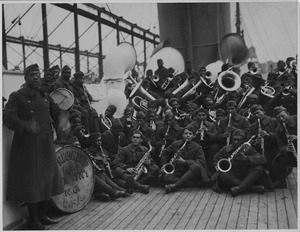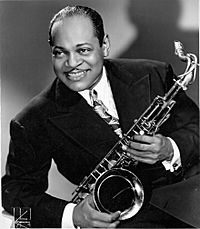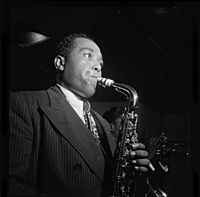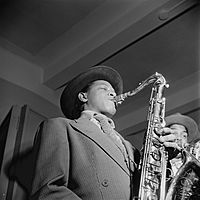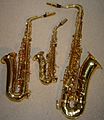Saxophone facts for kids
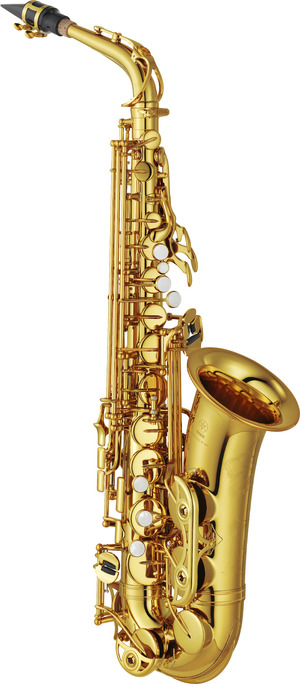
An alto saxophone
|
|
| Woodwind instrument | |
|---|---|
| Classification | |
| Hornbostel–Sachs classification | 422.212-71 (Single-reeded aerophone with keys) |
| Inventor(s) | Adolphe Sax |
| Developed | 28 June 1846 |
| Playing range | |
|
|
|
| Related instruments | |
|
Military band family:
Orchestral family:
Other saxophones:
|
|
| Musicians | |
|
|
A saxophone is a musical instrument that is made of brass and often just called a "sax". Due to the fact it is made from brass it is often involved in what is referred to as a brass section alongside true brass instruments like the trumpet or trombone. However, it is not a true brass instrument but a member of the woodwind family of instruments because it has a reed. It was developed from the clarinet and shares many similarities to the clarinet. The player blows into a reed fitted into the mouthpiece of the instrument.
There are several different kinds of saxophone. In order from low to high pitch they are: tubax, contrabass, bass, baritone, tenor, alto, soprano, sopranino, and soprillo. However, only the baritone, tenor, alto, and soprano are commonly used.
It was invented in 1842 by Adolphe Sax and is used in classical, jazz, and occasionally in rock, pop, and other styles. The big bands of the 1940s and 1950s always used it too. Famous saxophone players were Marcel Mule (classical music) and Charlie Parker (jazz music).
The saxophone family is known as a transpositional family of instruments due to the fact that you do not have to alter the fingering when playing different ones.
Contents
Description
Pitch and range
In the keyed (below overtone-produced altissimo) ranges of the various saxophones, the pitch is controlled by keys with shallow cups in which are fastened leather pads that seal toneholes, controlling the resonant length, and thereby frequency, of the air column within the bore. Small holes called vents, located between the toneholes and the mouthpiece, are opened by an octave key to raise the pitch by eliminating the fundamental frequency, leaving the first harmonic as the frequency defining the pitch. Most modern saxophones are keyed to produce a low B♭ (relative to the instrument's transposition) with all keys closed; modern baritone saxophones commonly play a low A and altos keyed to low A have been produced in the past. The highest keyed note has traditionally been F two and a half octaves above low B♭, while the keyed range is extended to F♯ on most recent performance-class instruments. A high G key is most common on modern soprano saxophones. Notes above F are considered part of the altissimo register of any saxophone, and can be produced using advanced embouchure techniques and fingering combinations. Keywork facilitating altissimo playing is a feature of modern saxophones. Modern saxophone players have extended the range to over four octaves on tenor and alto. Music for most saxophones is usually notated using treble clef.
Because all saxophones use the same key arrangement and fingering to produce a given notated pitch, it is not difficult for a competent player to switch among the various sizes when the music has been suitably transposed, and many do so. Since the baritone and alto are pitched in E♭, players can read concert pitch music notated in the bass clef by reading it as if it were treble clef and adding three sharps to the key signature. This process, referred to as clef substitution, makes it possible for the Eb instruments to play from parts written for baritone horn, bassoon, euphonium, string bass, trombone, or tuba. This can be useful if a band or orchestra lacks one of those instruments.
Uses
In military bands and classical music
The saxophone first gained popularity in military bands. Although the instrument was initially ignored in Germany, French and Belgian military bands were quick to include the instrument in their ensembles. Most French and Belgian military bands incorporate at least a quartet of saxophones, comprising an E♭ baritone, B♭ tenor, E♭ alto and B♭ soprano. These four instruments have proved the most popular of all of Sax's creations, with the E♭ contrabass and B♭ bass usually considered impractically large and the E♭ sopranino insufficiently powerful. British military bands tend to include at minimum two saxophonists, on the alto and tenor.
The saxophone was introduced into the concert band, which usually calls for an E♭ alto saxophone, a B♭ tenor saxophone, and an E♭ baritone saxophone. A concert band may include two altos, one tenor, and one baritone. A B♭ soprano saxophone is also used, in which case it is played by the first alto saxophonist. A bass saxophone in B♭ is used in some concert band music (especially music by Percy Grainger).
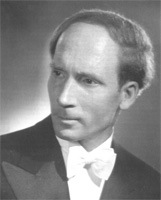
Saxophones are used in chamber music, such as saxophone quartets and other chamber combinations of instruments. The classical saxophone quartet consists of a B♭ soprano saxophone, E♭ alto saxophone, B♭ tenor saxophone, and E♭ baritone saxophone (SATB). On occasion, the soprano is replaced with a second alto sax (AATB); a few professional saxophone quartets have featured non-standard instrumentation, such as James Fei's Alto Quartet (four altos).
There is a repertoire of classical compositions and arrangements for the SATB instrumentation dating back to the nineteenth century, particularly by French composers who knew Sax. However, the largest body of chamber works for saxophone are from the modern era of classical saxophone initiated by Marcel Mule in 1928. Sigurd Raschèr followed as a soloist in orchestral works, starting in 1931, and also figured prominently in development of modern classical saxophone repertoire. The Mule quartet is often considered the prototype for quartets due the level of virtuosity demonstrated by its members and its central role in the development of modern quartet repertoire. However, organized quartets existed before Mule's ensemble, the prime example being the quartet headed by Edward A. Lefebre (1834–1911), which was a subset of Patrick Gilmore's 22nd Regiment band between 1873 and 1893.
In the 20th and 21st centuries, the saxophone found increased popularity in symphony orchestras. The instrument has also been used in genres such as opera and choral music. Many musical theatre scores include parts for saxophone, sometimes doubling another woodwind or brass instrument.
In jazz and popular music
Coincident with the more widespread availability of saxophones in the US around the turn of the century was the rise of ragtime music. The bands featuring the syncopated latin- and African-American rhythmic influences of ragtime were an exciting new feature of the American cultural landscape and provided the groundwork for new styles of dancing. The rise of dance bands into the 1920s followed from the popularity of ragtime. Two of the best known ragtime-playing brass bands with saxophones were those led by W. C. Handy and James R. Europe. The saxophone was also used in Vaudeville entertainment during the same period. Ragtime, Vaudeville, and dance bands introduced much of the American public to the saxophone. Europe's 369th Infantry Regiment Band popularized ragtime in France during its 1918 tour. Rudy Wiedoeft became the best known individual saxophone stylist and virtuoso during this period leading into the "saxophone craze" of the 1920s. Following it, the saxophone became featured in music as diverse as the "sweet" music of Paul Whiteman and Guy Lombardo, jazz, swing, and large stage show bands.
The rise of the saxophone as a jazz instrument followed its widespread adoption in dance bands during the early 1920s. The Fletcher Henderson Orchestra, formed in 1923, featured arrangements to back up improvisation, bringing the first elements of jazz to the large dance band format. Following the innovations of the Fletcher Henderson Orchestra, the Duke Ellington Orchestra and Jean Goldkette's Victor Recording Orchestra featured jazz solos with saxophones and other instruments. The association of dance bands with jazz would reach its peak with the swing music of the 1930s. The large show band format, influenced by the 1930s swing bands, would be used as backing for popular vocalists and stage shows in the post World War II era, and provided a foundation for big band jazz. Show bands with saxophone sections became a staple of television talk shows (such as the Tonight Show that featured bands led by Doc Severinsen and Branford Marsalis) and Las Vegas stage shows. The swing era fostered the later saxophone styles that permeated bebop and rhythm and blues in the early postwar era.
Coleman Hawkins established the tenor saxophone as a jazz solo instrument during his stint with Fletcher Henderson from 1923 to 1934. Hawkins' arpeggiated, rich-toned, vibrato-laden style was the main influence on swing era tenor players before Lester Young, and his influence continued with other big-toned tenor players into the era of modern jazz. Among the tenor players directly influenced by him were Chu Berry, Charlie Barnet, Tex Beneke, Ben Webster, Vido Musso, Herschel Evans, Buddy Tate, and Don Byas. Hawkins' band mate Benny Carter and Duke Ellington's alto saxophonist Johnny Hodges became influential on swing era alto styles, while Harry Carney brought the baritone saxophone to prominence with the Duke Ellington Orchestra. The New Orleans player Sidney Bechet gained recognition for playing the soprano saxophone during the 1920s, but the instrument did not come into wide use until the modern era of jazz.
As Chicago style jazz evolved from New Orleans jazz in the 1920s, one of its defining features was the addition of saxophones to the ensemble. The small Chicago ensembles offered more improvisational freedom than did the New Orleans or large band formats, fostering the innovations of saxophonists Jimmy Dorsey (alto), Frankie Trumbauer (c-melody), Bud Freeman (tenor) and Stump Evans (baritone). Dorsey and Trumbauer became important influences on tenor saxophonist Lester Young.
Lester Young's approach on tenor saxophone differed from Hawkins', emphasizing more melodic "linear" playing that wove in and out of the chordal structure and longer phrases that differed from those suggested by the tune. He used vibrato less, fitting it to the passage he was playing. His tone was smoother and darker than that of his 1930s contemporaries. Young's playing was a major influence on the modern jazz saxophonists Al Cohn, Stan Getz, Zoot Sims, Dexter Gordon, Wardell Gray, Lee Konitz, Warne Marsh, Charlie Parker, and Art Pepper.
The influence of Lester Young with the Count Basie Orchestra in the late 1930s and the popularity of Hawkins' 1939 recording of "Body and Soul" marked the saxophone as an influence on jazz equal to the trumpet, which had been the defining instrument of jazz since its beginnings in New Orleans. But the greatest influence of the saxophone on jazz was to occur a few years later when alto saxophonist Charlie Parker became an icon of the bebop revolution that influenced generations of jazz musicians. The small-group format of bebop and post-bebop jazz ensembles gained ascendancy in the 1940s as musicians used the harmonic and melodic freedom pioneered by Parker, Dizzy Gillespie, Thelonious Monk, and Bud Powell in extended jazz solos.
During the 1950s, prominent alto players included Sonny Stitt, Cannonball Adderley, Jackie McLean, Lou Donaldson, Sonny Criss and Paul Desmond, while prominent tenor players included Lester Young, Coleman Hawkins, Dexter Gordon, John Coltrane, Sonny Rollins, Stan Getz, Zoot Sims, Lucky Thompson, Eddie "Lockjaw" Davis, and Paul Gonsalves. Serge Chaloff, Gerry Mulligan, Pepper Adams and Leo Parker brought the baritone saxophone to prominence as a solo instrument. Steve Lacy renewed attention to the soprano saxophone in the context of modern jazz and John Coltrane boosted the instrument's popularity during the 1960s. Smooth jazz musician Kenny G also uses the soprano sax as his principal instrument.
Saxophonists such as John Coltrane, Ornette Coleman, Sam Rivers, and Pharoah Sanders defined the forefront of creative exploration with the avant-garde movement of the 1960s. The new realms offered with Modal, harmolodic, and free jazz were explored with every device that saxophonists could conceive of. Sheets of sound, tonal exploration, upper harmonics, and multiphonics were hallmarks of the creative possibilities that saxophones offered. One lasting influence of the avant-garde movement is the exploration of non-Western ethnic sounds on the saxophone, for example, the African-influenced sounds used by Sanders and the Indian-influenced sounds used by Coltrane. The devices of the avant-garde movement have continued to be influential in music that challenges the boundaries between avant-garde and other categories of jazz, such as that of alto saxophonists Steve Coleman and Greg Osby.
Some ensembles such as the World Saxophone Quartet use the soprano-alto-tenor-baritone (SATB) format of the classical saxophone quartet for jazz. In the 1990s, World Saxophone Quartet founder Hamiet Bluiett formed the quartet Baritone Nation (four baritones).
The "jump swing" bands of the 1940s gave rise to rhythm and blues, featuring horn sections and exuberant, strong-toned, heavily rhythmic styles of saxophone playing with a melodic sense based on blues tonalities. Illinois Jacquet, Sam Butera, Arnett Cobb, and Jimmy Forrest were major influences on R&B tenor styles and Louis Jordan, Eddie "Cleanhead" Vinson, Earl Bostic, and Bull Moose Jackson were major influences on alto. The R&B saxophone players influenced later genres including rock and roll, ska, soul, and funk. Horn section work continued with Johnny Otis and Ray Charles featuring horn sections and the Memphis Horns, the Phenix Horns, and Tower of Power achieving distinction for their section playing. Horn sections were added to the Chicago and West Coast blues bands of Lowell Fulson, T-Bone Walker, B.B. King, and Guitar Slim. The rock/soul fusion bands Chicago, The Electric Flag, and Blood, Sweat, and Tears featured horn sections. Junior Walker, King Curtis and Maceo Parker became influential soul and funk saxophone stylists. Bobby Keys and Clarence Clemons were well known rock & roll saxophone stylists.
Images for kids
-
Adolphe Sax, the inventor of the saxophone
-
In a rare early inclusion in an orchestral score, the saxophone was used in Gioacchino Rossini's Robert Bruce (1846)
-
Vintage silver-plated 'Pennsylvania Special' alto saxophone, manufactured by Kohlert & Sons for Selmer in Czechoslovakia, circa 1930
-
Yamaha YAS-25 alto saxophone. Circa 1990s
-
Yanagisawa A9932J alto saxophone: has a solid silver bell and neck with solid phosphor bronze body. The bell, neck and key-cups are extensively engraved. Manufactured in 2008
-
The lower portion of a P. Mauriat alto saxophone, showing the mother of pearl key touches and engraved brass pad cups
-
A Yamaha baritone saxophone
See also
 In Spanish: Saxofón para niños
In Spanish: Saxofón para niños








